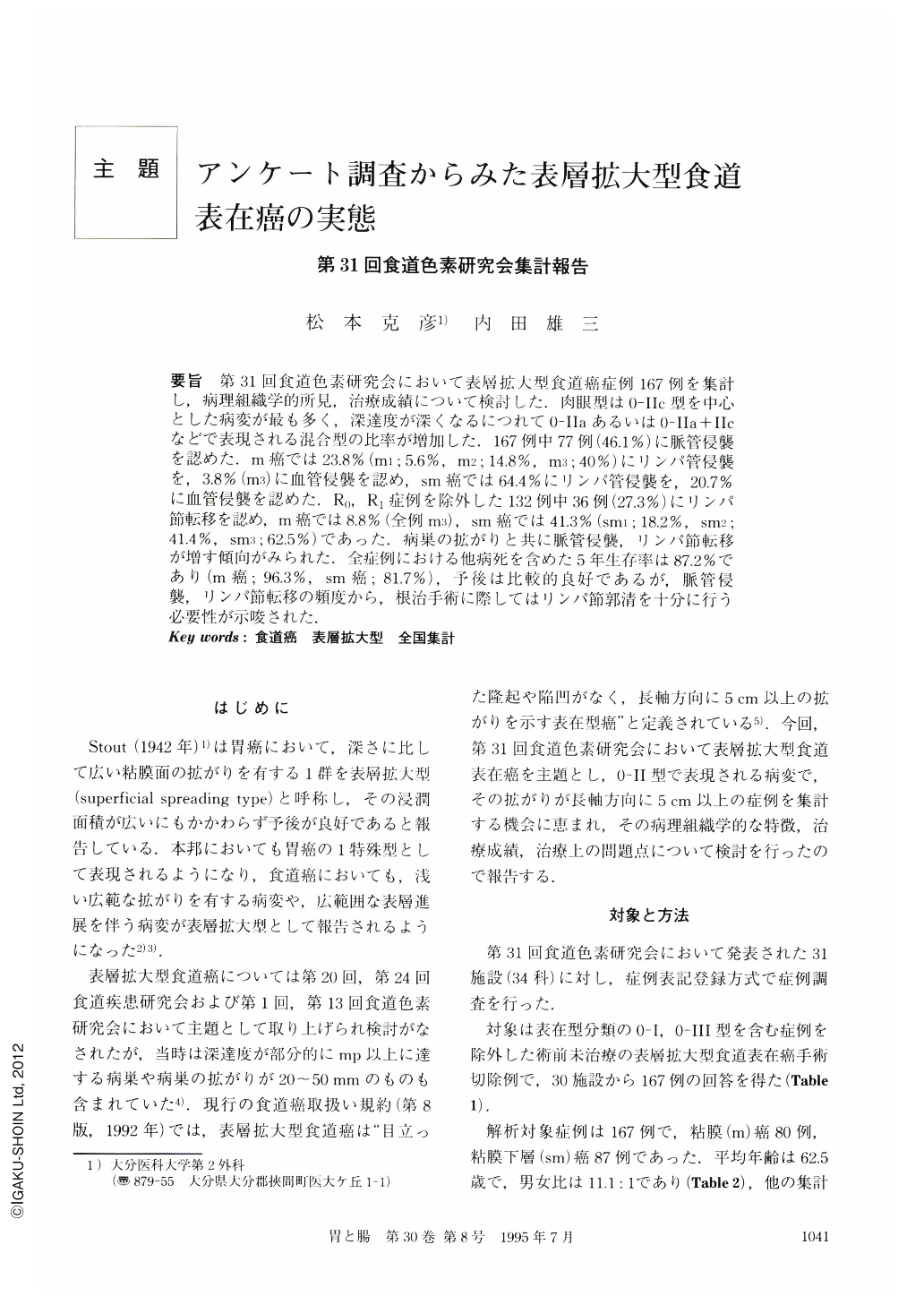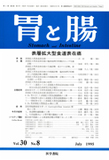Japanese
English
- 有料閲覧
- Abstract 文献概要
- 1ページ目 Look Inside
- サイト内被引用 Cited by
要旨 第31回食道色素研究会において表層拡大型食道癌症例167例を集計し,病理組織学的所見,治療成績について検討した.肉眼型は0-Ⅱc型を中心とした病変が最も多く,深達度が深くなるにつれて0-Ⅱaあるいは0-Ⅱa+Ⅱcなどで表現される混合型の比率が増加した.167例中77例(46.1%)に脈管侵襲を認めた.m癌では23.8%(m1;5.6%,m2;14.8%,m3;40%)にリンパ管侵襲を,3.8%(m3)に血管侵襲を認め,sm癌では64.4%にリンパ管侵襲を,20.7%に血管侵襲を認めた.R0,R1症例を除外した132例中36例(27.3%)にリンパ節転移を認め,m癌では8.8%(全例m3),sm癌では41.3%(sm1;18.2%,sm2;41.4%,sm3;62.5%)であった.病巣の拡がりと共に脈管侵襲,リンパ節転移が増す傾向がみられた.全症例における他病死を含めた5年生存率は87.2%であり(m癌;96.3%,sm癌;81.7%),予後は比較的良好であるが,脈管侵襲,リンパ節転移の頻度から,根治手術に際してはリンパ節郭清を十分に行う必要性が示唆された.
One hundred and sixty-seven cases of superficial spreading type of esophageal carcinoma collected from 30 institutions were analyzed to evaluate clinical features and histological risk factors (lymphatic and venous permeations, lymph node metastasis and prognosis) by subclassification of depth of their invasion and their length. Of these cases,80 were mucosal carcinoma and 87 were cases where the cancer had invaded to the submucosal layer.
Of all the cases, 83 (49.7%) were 0-Ⅱc type, and incidence of 0-Ⅱa and mixed type increased according to depth of invasion.
Of all the cases, 77 (46.1%) showed lymphatic or venous permeation and 36 of 132 cases (27.3%), excluding R0, and R1 cases, had lymph node metastasis. In mucosal carcinoma, 18 m1 cases revealed neither vessel permeation nor lymph node metastasis. But 4 of the 27 m2 cases (14.8%) and 14 of the 35 m3 cases (40.0%) showed vessel permeation, and 5 of the 27 m3 cases (18.5%), excluding R0 and R1 cases, had lymph node metastasis. In carcinoma invading the submucosal layer, 56 of the cases (64.4%) revealed lymphatic permeation and 18 cases (20.7%) showed venous permeation. Thirty-one of 75 cases (41.3%), excluding R0 and R1 cases, had lymph node metastasis. Increase in the area of spread of tumor was significantly correlated with the incidence of vessel permeation and lymph node metastasis, but this incidence increased as the length of the tumor increased.
The overall 5-year survival rates were 96.3% in mucosal carcinoma and 81.7% in carcinoma invading the submucosal layer. The prognosis of superficial spreading type of esophageal carcinoma was relatively satisfactory. Maximum length of tumor was not significantly correlated with the prognosis.
We concluded that it is necessary to remove the esophagus with sufficient lymph node dissection.

Copyright © 1995, Igaku-Shoin Ltd. All rights reserved.


